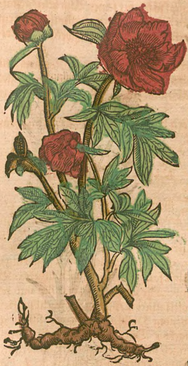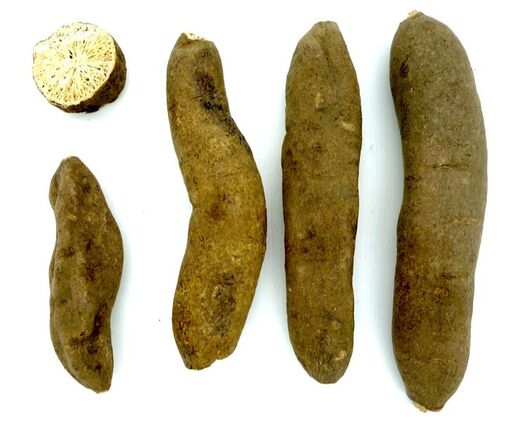Sentry Page Protection
Gart der Gesundheit, Cuba, 1485
Left: Male Peony; Right: Female Peony
Kreutterbuch, Matthiolus, 1586
Kreutterbuch, Matthiolus, 1586
Botanische wandplaten (1904–1914)
Botanical name:
Paeonia officinalis (syn. P. mollis) the 'Female' Peony
Others to supply the Peony of the West include:
Parts used:
Root; Flower; Seed
Temperature & Taste:
Neutral (Warm in the West), dry. Sour, slightly Bitter)
Classifications:
2C INCIDERS. 2F. PURIFYING. 2G. CLEANSING. 2I. ANTISPASMODIC. 2K. RESOLVENT
3G. EMMENAGOGUE
4a. CEPHALIC. 4f. SPLENETIC. 4j. NERVINE
Paeonia officinalis (syn. P. mollis) the 'Female' Peony
Others to supply the Peony of the West include:
- P. mascula (syn. P. corallina) the ‘Male’ Peony, found throughout Europe and Mid East
- P. clusii, P. parnassica (Greek Peony)
- P. emodii (Himalayan Peony)
- P. anomala (Russian Peony)
Parts used:
Root; Flower; Seed
Temperature & Taste:
Neutral (Warm in the West), dry. Sour, slightly Bitter)
Classifications:
2C INCIDERS. 2F. PURIFYING. 2G. CLEANSING. 2I. ANTISPASMODIC. 2K. RESOLVENT
3G. EMMENAGOGUE
4a. CEPHALIC. 4f. SPLENETIC. 4j. NERVINE
Uses:
1. Tonifies the Liver and Blood, Calms the Liver, Stops Wind:
-Epilepsy, Childhood convulsions, Apoplexy, Dizziness, Vertigo, Migraines
-nervous and spasmodic problems
-Nightmares, and traditionally for Lunacy
-‘All diseases of the head’.
-"Peony is useful in cases of Nightmare specially when 5-10 of its seeds are taken with water mead or wine" (Avicenna)
-The red seed of the plant called paeonia arrests haemorrhage; the root also is possessed of similar properties' (Pliny)
2. Tonifies the Blood, Promotes Menstruation:
-'One great remedy for all female diseases in common, is the black seed of the herbaceous plant paeonia, taken in hydromel: the root also is an effectual emmenagogue' (Pliny)
-‘it is good for women for diverse diseases’ (Bankes)
-obstruction or deficiency of the Womb, and to promote menstruation
-Uterine pain, taken with wine (Avicenna)
-'ten grains with honey wine, proves to be useful in cases of Hysteria due to Uterine pain'. (Avicenna)
-Swelling and inflammation of the Uterus
-Root or seed have been used to promote Fertility and Conception
-15 black seeds in powder were given in wine or mead for strangling Uterine pain
-10 red seeds can be given in wine for excessive menstruation.
-‘Peony seed when it is black it maketh deliverance of the bed of the child in her Womb’ taking 10 seeds as a dose.
-benefit to cleanse Postpartum (Avicenna)
3. Opens Obstructions of the Liver:
-Liver obstruction, congestion; Jaundice (Galen)
-Gall Stones (auxiliary)
-"Its roots are useful in Jaundice and for removing obstructions of the Liver" (Avicenna)
-"Peony clears the skin from black, spots" (Avicenna)
4. Promotes Urine:
-Kidney and Bladder pain
-Urinary stones; Incontinence
-"useful in Gout". (Avicenna)
5. Stops Cough and Asthma
-Cough, Spasmodic Cough including Whooping Cough; Asthma
Dose:
Seed and Root can be used in similar doses
Powder: 1–3 grams
in Decoction: 3–6 grams
Comment:
1. The European Peony and Chinese White Peony are almost analogous with the European being better to stop Wind and settles Spasms, the Chinese White Peony being more tonifying to the Blood and Yin. The Chinese Red Peony is Colder, less tonifying, and better to move the Blood and clear Heat from the Blood and Liver.
2. "It is useful in epilepsy even when suspended around the neck. We have found it useful in epilepsy by personal observations; as long as the drug remained suspended there were no epileptic attack but when it was removed the disease reappeared". (Avicenna)
Correctives:
1. Sugar
2. Milk
3. Rose conserve
4. Tragacanth
Substitute:
1. Sebesten (Unani)
2. Peony seed and root can generally be substituted for one another.
3. Chinese White Peony (Bai Shao) can generally be used for the Western Peony, although the Western Peony is stronger to settle internal Wind.
Seed and Root can be used in similar doses
Powder: 1–3 grams
in Decoction: 3–6 grams
Comment:
1. The European Peony and Chinese White Peony are almost analogous with the European being better to stop Wind and settles Spasms, the Chinese White Peony being more tonifying to the Blood and Yin. The Chinese Red Peony is Colder, less tonifying, and better to move the Blood and clear Heat from the Blood and Liver.
2. "It is useful in epilepsy even when suspended around the neck. We have found it useful in epilepsy by personal observations; as long as the drug remained suspended there were no epileptic attack but when it was removed the disease reappeared". (Avicenna)
Correctives:
1. Sugar
2. Milk
3. Rose conserve
4. Tragacanth
Substitute:
1. Sebesten (Unani)
2. Peony seed and root can generally be substituted for one another.
3. Chinese White Peony (Bai Shao) can generally be used for the Western Peony, although the Western Peony is stronger to settle internal Wind.
Main Combinations:
Peony & Licorice
Calamus & Peony
Mistletoe & Peony
Wind and Brain Diseases
1. Peony is often combined with Mistletoe in the treatment of Wind, spasms, convulsions and nervous diseases.
2. Headache, Peony with Angelica, Valerian, Stoechas, Nutmeg, Sage, Betony, Balm, Sandalwood
3. Cold Rheumatic diseases of the Head and Nerves, Peony with Guaiacum, Sassafras, Sage, Betony
4. Epilepsy, Convulsions:
i. Decoction of Peony root with Syrup of Stoechas (Herbarium Horstianum, 1630)
ii. Peony, Valerian
iii. Peony with Mistletoe, Pearl, Amber (as in Powder for Childhood Convulsions)
iv. Peony with Mistletoe, Valerian and White Dittany (as in Anti-Epileptic Powder)
v. Peony with Amber, Mistletoe, Deer horn, Fraxinella root (Formulaire Magistral et Memorial Pharmaceutique, 1823)
vi. Peony root & seed, Conserve of Peony flowers, with Amber, Pearl and Red Coral
vii. Peony with Licorice, Cinnamon, Nutmeg, Clove, Long Pepper, Saffron, Red Coral and Pearl (as in Electuary of Peony)
viii. Peony with Fraxinella root, Mistletoe, Red Coral, Hyacinth (Zircon), Gold leaf (Pharmacopoeia Wirtembergica, 1798)
ix. Peony with Amber, Mother of Pearl, Emerald, Aloeswood, Mistletoe, (Pulvis Cephalicus Albus from Pharmacopoeia Wirtembergica, 1798)
x. Peony with Saffron, Senna, Rhubarb, Ammonium chloride, Black Hellebore, Amber, Cinnamon (Formulaire de Montpellier, 1822)
xi. Childhood Epilepsy, Peony seed, Nutmeg, Lavender, Amber (Lazarus Riverius)
xii. Childhood Convulsions, Peony with Cinnabar and Nutmeg
5. Apoplexy:
i. Peony, Rosemary, Lavender, Costus, Siler Montane, Aniseed, Cinnamon, Clove, Amber (as in Powder Against Apoplexy of Zwelfer)
ii. Peony with Amber, Deer horn, Aloeswood, Lemon peel (as in Anti-Apoplectic Powder from Dispensatorium medico pharmaceuticum Palatinatus, 1764)
iii. Peony, Amber, Deer horn, Aloeswood, Citron peel, Pearl, Cinnamon (Powder for Apoplexy)
6. Epilepsy, Convulsions, Apoplexy, Peony with Siler Montane, Rosemary, Betony, Hyssop, Oregano, Rue, Aloeswood and Nutmeg (as in Syrup of Peony)
7. Vertigo:
i. Peony, Pearl, Red Coral, Amber (Electuary of Great Virtue for Vertigo)
ii. Peony seed, Mistletoe, Galangal, Calamus, Betony, Cubeb, Cumin
8. Paralysis, Peony, Licorice, Aniseed, Annis, Nutmeg, Elecampane (Electuary for Paralysis)
9. Lunatics, Peony root powder with Honey of Roses. (Avicenna)
Gynecology
9. Female Infertility:
i. Peony, Seseli, Cinnamon, Cyperus, Mugwort, Frankincense, Mastic (as in Electuary Against Sterility of Nicholas)
ii. Peony, Agnus Castus, Coriander, Myrtle berry, Conserve of Rose (Electuary Against Sterility)
iii. Peony seed, Mandrake, Musk
10. Hysteria, Peony root, Mistletoe, Zedoary, Lovage root, Myrrh, Feverfew (Lazarus Riverius)
Other:
9. Catarrh, Children's Coughs, Peony with Orris, Serpentaria, Saffron (Dispensatorium medico pharmaceuticum Palatinatus, 1764)
10. Consumption, Peony with Harts-tongue, Maidenhair, Hyssop, Balm, Licorice
Major Formulas
Decoction to Strengthen the Head (Wirtzung)
Cephalic Decoction (Charras)
Electuary of Peony
Electuary Against Sterility (Nicholas)
Electuary Against Sterility (Renodeus)
Electuary of Great Virtue for Vertigo (Hartman)
Electuary of Seseli (Nicholas)
Electuary for Paralysis
Powder of Mistletoe and Peony (Gabelhover)
Powder for Epilepsy (Quincy)
Powder for Apoplexy (Wirtenberg)
Powder for Childhood Convulsions
Powder of Marquis
Special Powder for Epilepsy (Wirtzung)
Special Powder for Memory (Wirtzung)
Tincture for Paralysis
Cautions:
1. Overdose (4 grams of the powder) can cause Headache, Tinnitus, Colic and Vomiting.
Main Preparations used:
Distilled Water of the Roots and Flowers, Syrup of the Infusion of the Flowers, Extract of the dried Flowers, Conserve of the Flowers, Salt of the Ashes
1. Conserve of Peony:
i. Peony petals (1 part), White Sugar (2 parts). Beat.
2. Distilled Water of Peony:
i. Peony flowers (1 part), Water (4 parts). Distil half. (Pharmacopoeia Sardoa, 1773)
1. Overdose (4 grams of the powder) can cause Headache, Tinnitus, Colic and Vomiting.
Main Preparations used:
Distilled Water of the Roots and Flowers, Syrup of the Infusion of the Flowers, Extract of the dried Flowers, Conserve of the Flowers, Salt of the Ashes
1. Conserve of Peony:
i. Peony petals (1 part), White Sugar (2 parts). Beat.
2. Distilled Water of Peony:
i. Peony flowers (1 part), Water (4 parts). Distil half. (Pharmacopoeia Sardoa, 1773)
Click the Tabs above for more information on this Medicine
|
'This drug is the Female Peony of Dioscorides, and was esteemed by the ancients as a valuable remedy in uterine obstructions, colic, bilious obstructions, dropsy, epilepsy, convulsions and hysteria. Dioscorides describes two kinds of Peony, male, P. corallina, and female, P. officinalis, these are the two kinds of Fawania described by Arabic and Persian writers. The roots of the first are turnip-shaped and about as thick as the thumb; those of the second consist of oblong tubercles attached by a stout fibre to a rhizome ... Ud-salap is used by the natives as a blood purifier for children. In the time
|
of Galen a superstition prevailed that Peony root enclosed in a bag and hung round a child's neck both prevented epileptic attacks and cured them, and this belief is not extinct among the peasantry of Europe even now; they also believe that wearing the seeds will prevent the dangers of dentition. The plant has been proved not to be inert; it produces headache, noise in the ears, confused vision, colic and vomiting if taken in full doses (60grs.) (Vegetable Materia Medica of Western India, Dymock, 1885)
|









